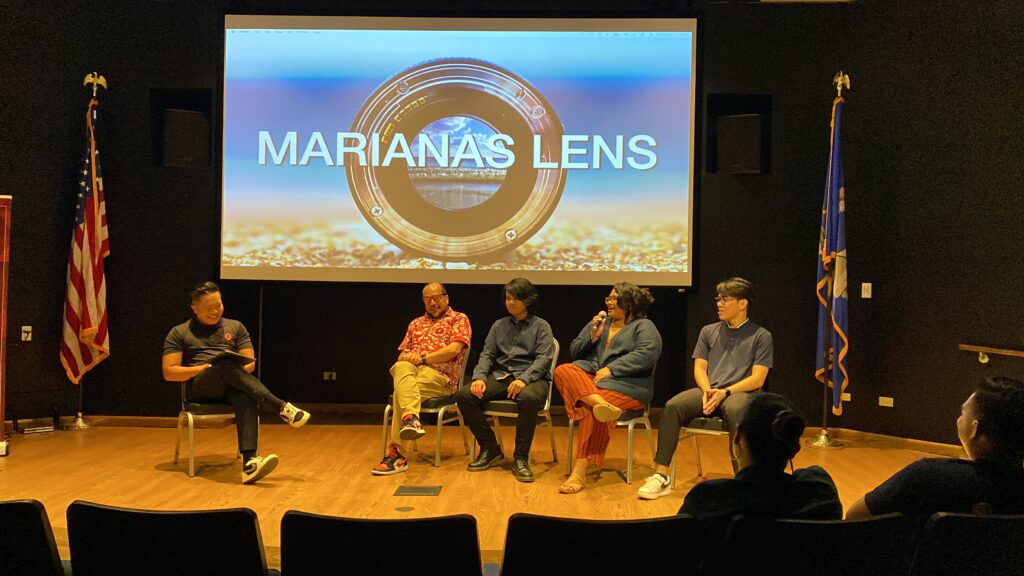
Kevin Bautista, left, of Northern Marianas College moderates a storytelling panel comprising, from 2nd left, NMC President Galvin Deleon Guerrero, Jedric Villar, Victoria Deleon Guerrero, and Fenedel Buno.
THE Marianas Lens film screening event on Thursday, Aug. 22 at the American Memorial Park theater showcased local filmmakers and featured a panel discussion on storytelling in the Marianas.
The event was sponsored by Northern Marianas College as a welcoming activity for its students, whose fall semester classes started last week.
Dozens of residents attended the screening of five films: “Steps on the Shore” by Elijah Pajarillaga, “Two of a Kind” by Jedric Villar, “Home’s Second Chance” by Sheryne Yang, “Tala” by Justin Ocampo, and “ISLA: Isla’n Esperånsa” by NMC President Galvin Deleon Guerrero.
According to a film synopsis, Pajarillaga’s “Steps on the Shore” follows a high school graduate during his last days on Saipan before heading off to college as he grapples with lingering conflicts involving family and his sense of belonging to the island. Pajarillaga is a 2021 graduate of Grace Christian Academy who is studying film at Wesleyan University in Connecticut.
Villar’s “Two of a Kind” is a modern Western about a wanderer who meets an unlikely ally to help clear the wanderer’s name. Villar graduated from Mount Carmel School in 2021 and is studying film at Montclair State University in New Jersey. He was present at the panel discussion on Thursday.
Yang’s “Home’s Second Chance” is a visual poem about the “beauty and tragedy” of Saipan. The film was produced as part of NMC’s 2023 Cinema on Saipan summer seminar.
In Ocampo’s “Tala,” a naive girl struggles with the reality that her father is not the ideal man she’s built him up to be as she works toward reconciliation with the other members of her family.
Ocampo graduated with degrees in Digital Cinema and American Studies from the University of Hawaiʻi at Mānoa and is now the lead media specialist for the Honolulu City Council.
Deleon Guerrero’s “ISLA: Isla’n Esperånsa” follows a high school math genius who enters the island’s criminal underworld of high-stakes gambling in order to earn enough money to take him and his family to the states.
Panel discussion
At the end of the screening, Villar and Deleon Guerrero were on stage to discuss their films. They were joined by Fenedel Buno, director of photography for “ISLA: Isla’n Esperånsa,” and Victoria Deleon Guerrero, who acted in “Isla’n Esperånsa.” The other filmmakers were in the states.
Galvin Deleon Guerrero described why he is a “firm believer in empowering local storytellers.”
“No one else is going to be able to tell our stories as well and as authentically and [respectfully] as we can,” he said. “We got to be able to tell our own stories.”
His daughter, Victoria Deleon Guerrero, spoke about local storytelling’s ability to represent values and visuals the community can identify with.
“I think for one it’s refreshing to see someone who looks like you in the film or on stage and it’s not a western story, but it’s our story,” she said. “Even though we’re Americans, we’re a melting pot of the Pacific and Asia, and … telling our stories isn’t just to appeal to an American audience. It’s to appeal to the cultures that we represent here in the Marianas and letting that be the seed to grow into something bigger so that when we’re looking at the stage and we’re looking at the screen we see a story that resonates with us.”
Buno said he has an information technology and graphic design background, but was challenged to learn through experience when filming “Isla’n Esperånsa.”
He said he grew to appreciate the “beauty in film” and learned to see the storytelling capability of visuals.
“I tried to train myself [to see] there’s storytelling in visuals too,” he said. “In some parts of the film I tried to tell a character’s influence in the film through the angle or shot that I did.”
For his part, Villar encouraged more residents to get into filmmaking. He said it’s just a matter of practice.
He said as a child, he used his mother’s camera to film scenes. These days, he said smartphone technology can be a way to break into storytelling.
“Now you can literally film a movie with your phone,” he said. “Anyone here can make a movie, just as long as you really want to do it and actually do it.”











